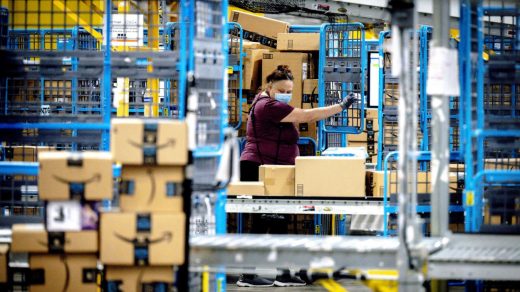Amazon was cited for ‘serious’ worker safety violations. Why was the fine only $60,000?
Following a months-long investigation, the Occupational Safety and Health Administration issued multiple citations against Amazon this week for serious worker safety violations. Acting on a referral by federal prosecutors to inspect six Amazon warehouses across the country, the agency found workers were at high risk for “lower back injuries and other musculoskeletal disorders” as they rapidly twisted, bent, and made long reaches to meet the tech giant’s grueling physical demands.
OSHA also found workers at an Amazon warehouse in Deltona, FL, were at risk for “serious heat-related illnesses,” and that employees there had suffered repeated injuries from improperly secured packages, including a 61-pound piece of furniture that smashed one worker’s face and a bed frame that crushed a worker’s hand.
But something else stands out in OSHA’s announcement: the paltry fine. The penalties totalling $60,629 already represent the maximum fine possible for “serious violations”: $15,625 for the three Amazon warehouses found in violation (in New Windsor, NY; Waukegan, IL; and Deltona), plus a fourth $13,394 penalty—also against Deltona—for stacking merchandise dangerously high in “very narrow aisles” and exposing employees to falling merchandise while unloading trailers.
Deborah Berkowitz, OSHA’s chief of staff during the Obama administration and now a fellow at Georgetown researching worker safety, says the latest citations were “actually very substantive and based on a very extensive and science-based investigation” by the agency. OSHA’s hazard alert notice to Amazon included charts showing its workers’ “unacceptable” risks of musculoskeletal injuries, with numbers highlighted in red. “I think [OSHA] did this intentionally because Amazon seems intent on ignoring the science,” she says.
Not that there’s ever been a high federal penalty for doing so. The original Occupational Safety and Health Act of 1970, which created the agency, had a maximum fine of just $1,000 for serious violations. That was raised to $7,000 in 1990, remaining unchanged until 2016, after the Obama administration passed a budget that required the penalties to be adjusted with inflation. Increasing OSHA’s maximum penalties beyond that would require another act of Congress, and that seems very unlikely in the current environment, Berkowitz said. “OSHA’s penalties have historically been low, mostly because of tremendous lobbying by the Chamber of Commerce, the National Association of Manufacturers and their political representatives.”
Under current rules, OSHA can levy harsher penalties—up to $156,259 if it finds a “willful violation”—but to prove a company acted willfully, “OSHA would have to gather a whole lot more data,” Berkowitz says. The problem is that the agency has been “chronically underfunded,” with Republicans especially hostile to increasing its budget: At the agency’s staffing levels, it would take 160 years to inspect every workplace in the country even one time, the former official said. While working there, “I felt a little bit like Mighty Mouse; you have to puff yourself up to look bigger.”
As a result, behemoths like Amazon get off with a slap on the wrist for systematically endangering their workers. (And even though those fines are a drop in the bucket for a company with a nearly $1 trillion market cap, Amazon is fighting back anyway. “We strongly disagree with these allegations and intend to appeal. We’ve cooperated fully, and the government’s allegations don’t reflect the reality of safety at our sites,” said Amazon spokesperson Kelly Nantel in an emailed statement.)
In the end, it’s not the fine that changes companies’ behavior, but the message that it sends. Other companies cited by OSHA for ergonomic violations have been quick to reform their practices, says Berkowitz, “because in the end, it saves them money. It prevents injuries, it’s good for the worker, it’s good for the company. So the fact that Amazon built all these warehouses and ignores ergonomic principles . . . it’s stunning to me.”
(16)



